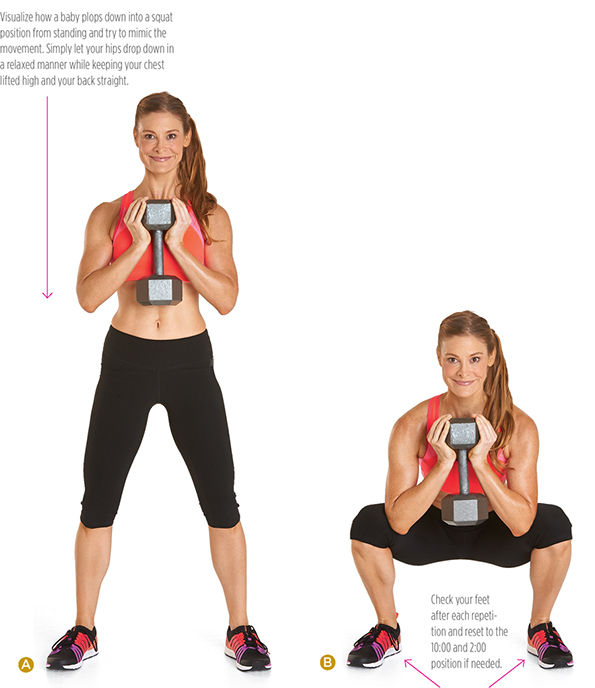*kitten* to the grass squatting

AngInCanada
Posts: 947 Member
I've done Les Mills Pump videos on and off for the past year and I just started a round today that I'm going to follow through from start to finish.
Anyways, they don't squat super low (mostly parallel or just above) in the video but I want to start squatting lot (*kitten* to the grass as they say). Problem is, I cant even get parallel without feeling like my inner thighthare going
to tear apart. I've worked on stretching out my hamstrings but hasn't done much so wondering if anyone has any advice?
Thanks!
Anyways, they don't squat super low (mostly parallel or just above) in the video but I want to start squatting lot (*kitten* to the grass as they say). Problem is, I cant even get parallel without feeling like my inner thighthare going

to tear apart. I've worked on stretching out my hamstrings but hasn't done much so wondering if anyone has any advice?
Thanks!
0
Replies
-
are you tight before you squat? Take a minute to focus and get your legs tight and squeeze all your muscles as hard as you can, this will take the pressure off your inner thighs. You have to press your knees out throughout the entire movement. torque your feet into the ground. Open at the hips, pressing your knees out. Stay tight, every muscle engaged. Some people think about spreading the floor with their feet on the way up. I'd suggest not switching to goblet, but keep the bar on your back, if you need to go lighter, go with less weight on the bar.5
-
AngInCanada wrote: »Anyways, they don't squat super low (mostly parallel or just above) in the video but I want to start squatting lot (*kitten* to the grass as they say). Problem is, I cant even get parallel without feeling like my inner thighthare going to tear apart.
Those are your hip adductor muscles. Try stretching them in a chair a few times a day for 30+ seconds:
exrx.net/Stretches/HipAdductors/SeatedAdductorMagnus.html
Also practice holding a deep squat for 30+ seconds, with no weights, daily. This explains how:
stack.com/a/third-world-squat
Post an update next week. 3
3 -
are you tight before you squat? Take a minute to focus and get your legs tight and squeeze all your muscles as hard as you can, this will take the pressure off your inner thighs. You have to press your knees out throughout the entire movement. torque your feet into the ground. Open at the hips, pressing your knees out. Stay tight, every muscle engaged. Some people think about spreading the floor with their feet on the way up. I'd suggest not switching to goblet, but keep the bar on your back, if you need to go lighter, go with less weight on the bar.
I only had 10 lb plates on. I could just use the bar (I believe it's 5 lbs). But it doesn't feel heavy at all. I will do what you've suggested though and try it out 0
0 -
Cutaway_Collar wrote: »It takes time and practice. If the body is saying no, then you run the risk of injuring yourself. So don't take your *kitten* to the grass yet.
Get a trainer to watch your form initially and then they will be able to assist on position and application.
I got a trainer once. She almost killed me. Seriously. I spent half hour sitting on the gym floor not able to stand after I repeatedly told her I needed to back off a little because I was really dizzy. She appologized after and said she wasn't going to charge me for the session lol. I should just try another one, but the thought makes me anxious0 -
Cherimoose wrote: »AngInCanada wrote: »Anyways, they don't squat super low (mostly parallel or just above) in the video but I want to start squatting lot (*kitten* to the grass as they say). Problem is, I cant even get parallel without feeling like my inner thighthare going to tear apart.
Those are your hip adductor muscles. Try stretching them in a chair a few times a day for 30+ seconds:
exrx.net/Stretches/HipAdductors/SeatedAdductorMagnus.html
Also practice holding a deep squat for 30+ seconds, with no weights, daily. This explains how:
stack.com/a/third-world-squat
Post an update next week.
Awesome! Will do!
0 -
Cutaway_Collar wrote: »
What the motherfudge... That sucks.AngInCanada wrote: »Cutaway_Collar wrote: »It takes time and practice. If the body is saying no, then you run the risk of injuring yourself. So don't take your *kitten* to the grass yet.
Get a trainer to watch your form initially and then they will be able to assist on position and application.
I got a trainer once. She almost killed me. Seriously. I spent half hour sitting on the gym floor not able to stand after I repeatedly told her I needed to back off a little because I was really dizzy. She appologized after and said she wasn't going to charge me for the session lol. I should just try another one, but the thought makes me anxious
I would ask around with some students prior to picking one. The students/clients will tell you who is good and who isn't. Someone said goblet squats. That is a good exercise to practice form. Did you try just with the 45lb barbell first?
Lol the barbell is only 5 lbs. Not 450 -
amyrebeccah wrote: »I would start lighter, try goblet squats.

This girl freaks me out. No one is that happy when they squat.
15 -
Kelll12123 wrote: »amyrebeccah wrote: »I would start lighter, try goblet squats.

This girl freaks me out. No one is that happy when they squat.
Hahaha. I like squats but hate lunges. Would rather get a root canal.0 -
I like the suggestion of goblet squats. Having some weight helps push you down, and they are somewhat easier and different because you hold the weight in front. I think you should try it.0
-
Goblet squats are actually a fantastic suggestion in some cases because there is a strong balance component associated with squatting.
Typically people are able to go deeper into a goblet squat than they are with a barbell (the load in front better counter-balances the hips going back) and so the goblet squat can be used as a tool to teach people proper squatting mechanics while still giving a good training stimulus and frequent goblet squatting can also improve the mobility required to barbell squat since you're taking your joints through a similar ROM.
Goblet squats also MAY have a slightly lower recovery component since you're using (typically) lower loads -- and this is potentially valuable because it makes them a good option for doing at a high frequency. Possibly even daily if you don't overload too much.
If it were ME I would do the following things:
1) Goblet squat frequently.
2) Practice the barbell squat 3-5 times per week with the empty barbell to start
3) Experiment with stance width and toe angle in such a way that you start at shoulder width, do a couple of reps, go 2-3" wider, repeat, go narrower, repeat, evaluate which feels best and which is easiest to get deeper with, and start with that stance width.
10 -
Oh and I should also add -- there's no need to go all the way to the floor with it, but it would be a good idea to get a bit below parallel if you're capable of it.3
-
Alright. Goblet squat - check. Hip adductor stretches - check. Thanks everyone!1
-
If I squat with a wide stance (not as wide as sumo) I have trouble with depth. Your stance seems pretty wide so you might narrow it a bit. Try rotating your feet out a bit more and see how that feels with a narrower stance.
Around shoulder width or so.
Stance is an individual thing so feel free to experiment until you find what works.
Good luck.1 -
amyrebeccah wrote: »AngInCanada wrote: »Kelll12123 wrote: »amyrebeccah wrote: »I would start lighter, try goblet squats.

This girl freaks me out. No one is that happy when they squat.
Hahaha. I like squats but hate lunges. Would rather get a root canal.
Truth.
yup !! same here.1 -
Kelll12123 wrote: »This girl freaks me out. No one is that happy when they squat.
Depends on how backed up they were before hand.
*couldn't resist*
1 -
As mentioned earlier, sit in a squat a few times per day everyday. I started this a few weeks ago and could barely sit there for 30 seconds. I can sit in a squat for 2 mins or more now. I have to say I've been a little hit and miss doing it but, it works.1
-
Tight hip flexors are a major cause of not getting to parallel or lower.
https://www.t-nation.com/training/break-up-those-hips-and-fix-that-squat2 -
Following advice given to me on this forum, I have been squatting with my heels on a couple of plates. I can squat deep while doing this and also practice without my heels raised. I am improving for sure and wonder that maybe some bodies just need to learn a pattern of movement.1
-
Good advice already.
Would say don't give up on working with a trainer. Do try to find a good one.
I went with a place that trains athletes - private gym.
Starting this at 46 w/stuff to deal with like knee issues I really wanted to get it right and learn good form.
So far so good. Back squat was the first thing we added w/a barbell. Haven't added weight yet, but do a lot of lower body work - lunges, split squat, goblet squats on and off plates, and balance work. Just added barbell bench press last week IIRC and barbell RDL yesterday - bar plus bumper plates. That is about 14 hours in.0 -
Goblet squats are actually a fantastic suggestion in some cases because there is a strong balance component associated with squatting.
Typically people are able to go deeper into a goblet squat than they are with a barbell (the load in front better counter-balances the hips going back) and so the goblet squat can be used as a tool to teach people proper squatting mechanics while still giving a good training stimulus and frequent goblet squatting can also improve the mobility required to barbell squat since you're taking your joints through a similar ROM.
Goblet squats also MAY have a slightly lower recovery component since you're using (typically) lower loads -- and this is potentially valuable because it makes them a good option for doing at a high frequency. Possibly even daily if you don't overload too much.
If it were ME I would do the following things:
1) Goblet squat frequently.
2) Practice the barbell squat 3-5 times per week with the empty barbell to start
3) Experiment with stance width and toe angle in such a way that you start at shoulder width, do a couple of reps, go 2-3" wider, repeat, go narrower, repeat, evaluate which feels best and which is easiest to get deeper with, and start with that stance width.
Agree with all this. It does sound like you have tight adductors which you can gain flexibility in as you get better at the movement. Starting with a more narrow stance and working your way out is a great suggestion for that. I would also add that videoing yourself from the side to check your form with each set will help you to learn what getting to depth feels like. Sometimes ankle flexibility can be an issue also, so make sure and warm them up too.
0 -
Can you squat past parallel with good form with just body weight? If not then practice practice practice. Part of my warm up every day is squatting past parallel with just body weight and holding it to warm up stretch hip flexor ankles etc.
If you can do this already the slowly add weight. Use a belt to help keep chest up. And look into front squats. Front squats really helped me a lot.0 -
Just to throw in my $0.02. There has been a lot of good advice, but also some poor advice.
First, the likelihood of you lacking the flexibility to squat is very close to zero. This is assuming you have no injury or anything else going on (which I'm guessing is no based on the fact that you didn't mention anything).
9/10 it is simply a lack of stability/control. Your body finds stability anyway it can - in this case it appears to be using your hips/adductors. This is the tightness you are feeling.
Without going too deep into things, take the advice of others above and stick with goblet squats until your have the strength/stability to do back squats.0 -
DreesPerformanceTraining wrote: »Just to throw in my $0.02. There has been a lot of good advice, but also some poor advice.
First, the likelihood of you lacking the flexibility to squat is very close to zero. This is assuming you have no injury or anything else going on (which I'm guessing is no based on the fact that you didn't mention anything).
9/10 it is simply a lack of stability/control. Your body finds stability anyway it can - in this case it appears to be using your hips/adductors. This is the tightness you are feeling.
Without going too deep into things, take the advice of others above and stick with goblet squats until your have the strength/stability to do back squats.
Would you be able to elaborate on flexibility vs. mobility? From what I have read, I would agree, that lacking flexibility to squat is not a problem, but mobility is.
I think many people confuse the 2.
Thanks.0 -
Heh... Rubbish. Squatterday is the best day ever!Kelll12123 wrote: »amyrebeccah wrote: »I would start lighter, try goblet squats.
This girl freaks me out. No one is that happy when they squat.
5 -
Packerjohn wrote: »DreesPerformanceTraining wrote: »Just to throw in my $0.02. There has been a lot of good advice, but also some poor advice.
First, the likelihood of you lacking the flexibility to squat is very close to zero. This is assuming you have no injury or anything else going on (which I'm guessing is no based on the fact that you didn't mention anything).
9/10 it is simply a lack of stability/control. Your body finds stability anyway it can - in this case it appears to be using your hips/adductors. This is the tightness you are feeling.
Without going too deep into things, take the advice of others above and stick with goblet squats until your have the strength/stability to do back squats.
Would you be able to elaborate on flexibility vs. mobility? From what I have read, I would agree, that lacking flexibility to squat is not a problem, but mobility is.
I think many people confuse the 2.
Thanks.
Sure.
There is a lot different terms and ways to look at it so I'll just break it down into two oversimplified groups.
Passive flexibility - The range of motion a joint or muscles has. Imagine someone stretching your hamstring as you lay on your back.
Active flexibility - The range of motion a muscle or joint has when being moved by the individual. Imagine laying on your back and lifting your leg.
If you have ever tried this, you know that your ROM is larger when someone is stretching your leg, compared to lifting it yourself. In the second example things like strength and joint stability come into play that can affect ROM.
In both scenarios the individual has the same length of muscle. Stretching the muscle is likely only to improve the individuals passive flexibility and not active flexibility, which would not benefit OP for her squats.0 -
DreesPerformanceTraining wrote: »Packerjohn wrote: »DreesPerformanceTraining wrote: »Just to throw in my $0.02. There has been a lot of good advice, but also some poor advice.
First, the likelihood of you lacking the flexibility to squat is very close to zero. This is assuming you have no injury or anything else going on (which I'm guessing is no based on the fact that you didn't mention anything).
9/10 it is simply a lack of stability/control. Your body finds stability anyway it can - in this case it appears to be using your hips/adductors. This is the tightness you are feeling.
Without going too deep into things, take the advice of others above and stick with goblet squats until your have the strength/stability to do back squats.
Would you be able to elaborate on flexibility vs. mobility? From what I have read, I would agree, that lacking flexibility to squat is not a problem, but mobility is.
I think many people confuse the 2.
Thanks.
Sure.
There is a lot different terms and ways to look at it so I'll just break it down into two oversimplified groups.
Passive flexibility - The range of motion a joint or muscles has. Imagine someone stretching your hamstring as you lay on your back.
Active flexibility - The range of motion a muscle or joint has when being moved by the individual. Imagine laying on your back and lifting your leg.
If you have ever tried this, you know that your ROM is larger when someone is stretching your leg, compared to lifting it yourself. In the second example things like strength and joint stability come into play that can affect ROM.
In both scenarios the individual has the same length of muscle. Stretching the muscle is likely only to improve the individuals passive flexibility and not active flexibility, which would not benefit OP for her squats.
Thanks much. Now how about mobility? To my understanding mobility is often an issue in squatting or other movements.
I think people often refer to lack of mobility as a flexibility issue.0 -
Packerjohn wrote: »DreesPerformanceTraining wrote: »Packerjohn wrote: »DreesPerformanceTraining wrote: »Just to throw in my $0.02. There has been a lot of good advice, but also some poor advice.
First, the likelihood of you lacking the flexibility to squat is very close to zero. This is assuming you have no injury or anything else going on (which I'm guessing is no based on the fact that you didn't mention anything).
9/10 it is simply a lack of stability/control. Your body finds stability anyway it can - in this case it appears to be using your hips/adductors. This is the tightness you are feeling.
Without going too deep into things, take the advice of others above and stick with goblet squats until your have the strength/stability to do back squats.
Would you be able to elaborate on flexibility vs. mobility? From what I have read, I would agree, that lacking flexibility to squat is not a problem, but mobility is.
I think many people confuse the 2.
Thanks.
Sure.
There is a lot different terms and ways to look at it so I'll just break it down into two oversimplified groups.
Passive flexibility - The range of motion a joint or muscles has. Imagine someone stretching your hamstring as you lay on your back.
Active flexibility - The range of motion a muscle or joint has when being moved by the individual. Imagine laying on your back and lifting your leg.
If you have ever tried this, you know that your ROM is larger when someone is stretching your leg, compared to lifting it yourself. In the second example things like strength and joint stability come into play that can affect ROM.
In both scenarios the individual has the same length of muscle. Stretching the muscle is likely only to improve the individuals passive flexibility and not active flexibility, which would not benefit OP for her squats.
Thanks much. Now how about mobility? To my understanding mobility is often an issue in squatting or other movements.
I think people often refer to lack of mobility as a flexibility issue.
Mobility is being able to use your flexibility to do movements. You need mobility for yoga - you may be flexible but have to be able to move through and hold the positions, too. active flexibility, just a different word.0 -
Packerjohn wrote: »DreesPerformanceTraining wrote: »Packerjohn wrote: »DreesPerformanceTraining wrote: »Just to throw in my $0.02. There has been a lot of good advice, but also some poor advice.
First, the likelihood of you lacking the flexibility to squat is very close to zero. This is assuming you have no injury or anything else going on (which I'm guessing is no based on the fact that you didn't mention anything).
9/10 it is simply a lack of stability/control. Your body finds stability anyway it can - in this case it appears to be using your hips/adductors. This is the tightness you are feeling.
Without going too deep into things, take the advice of others above and stick with goblet squats until your have the strength/stability to do back squats.
Would you be able to elaborate on flexibility vs. mobility? From what I have read, I would agree, that lacking flexibility to squat is not a problem, but mobility is.
I think many people confuse the 2.
Thanks.
Sure.
There is a lot different terms and ways to look at it so I'll just break it down into two oversimplified groups.
Passive flexibility - The range of motion a joint or muscles has. Imagine someone stretching your hamstring as you lay on your back.
Active flexibility - The range of motion a muscle or joint has when being moved by the individual. Imagine laying on your back and lifting your leg.
If you have ever tried this, you know that your ROM is larger when someone is stretching your leg, compared to lifting it yourself. In the second example things like strength and joint stability come into play that can affect ROM.
In both scenarios the individual has the same length of muscle. Stretching the muscle is likely only to improve the individuals passive flexibility and not active flexibility, which would not benefit OP for her squats.
Thanks much. Now how about mobility? To my understanding mobility is often an issue in squatting or other movements.
I think people often refer to lack of mobility as a flexibility issue.
Mobility is the same thing as active flexibility in my example. I used that term so everyone could see that they are related, but not the same.0 -
Chiming in with suggesting goblet squats, and also front squats with the barbell in front of you instead of across your shoulders. Both will help you with mechanics. Watch Youtube videos, and just keep practicing.
As for other things, anatomy is different for everyone. Some need to have a more narrow stance, others wider with toes pointed outward. I'm not a deep squatter, and too wide a stance feels weird, but I need my toes pointed out to keep my knees aligned. I aim for just below parallel, which feels really deep to me.0 -
Meh...I've never been able to squat below parallel. It really doesn't bother me.
Just don't quarter squat. Those people look like total douches in the gym.0
This discussion has been closed.
Categories
- All Categories
- 1.4M Health, Wellness and Goals
- 398.2K Introduce Yourself
- 44.7K Getting Started
- 261K Health and Weight Loss
- 176.4K Food and Nutrition
- 47.7K Recipes
- 233K Fitness and Exercise
- 462 Sleep, Mindfulness and Overall Wellness
- 6.5K Goal: Maintaining Weight
- 8.7K Goal: Gaining Weight and Body Building
- 153.5K Motivation and Support
- 8.4K Challenges
- 1.4K Debate Club
- 96.5K Chit-Chat
- 2.6K Fun and Games
- 4.8K MyFitnessPal Information
- 12 News and Announcements
- 21 MyFitnessPal Academy
- 1.5K Feature Suggestions and Ideas
- 3.2K MyFitnessPal Tech Support Questions


















